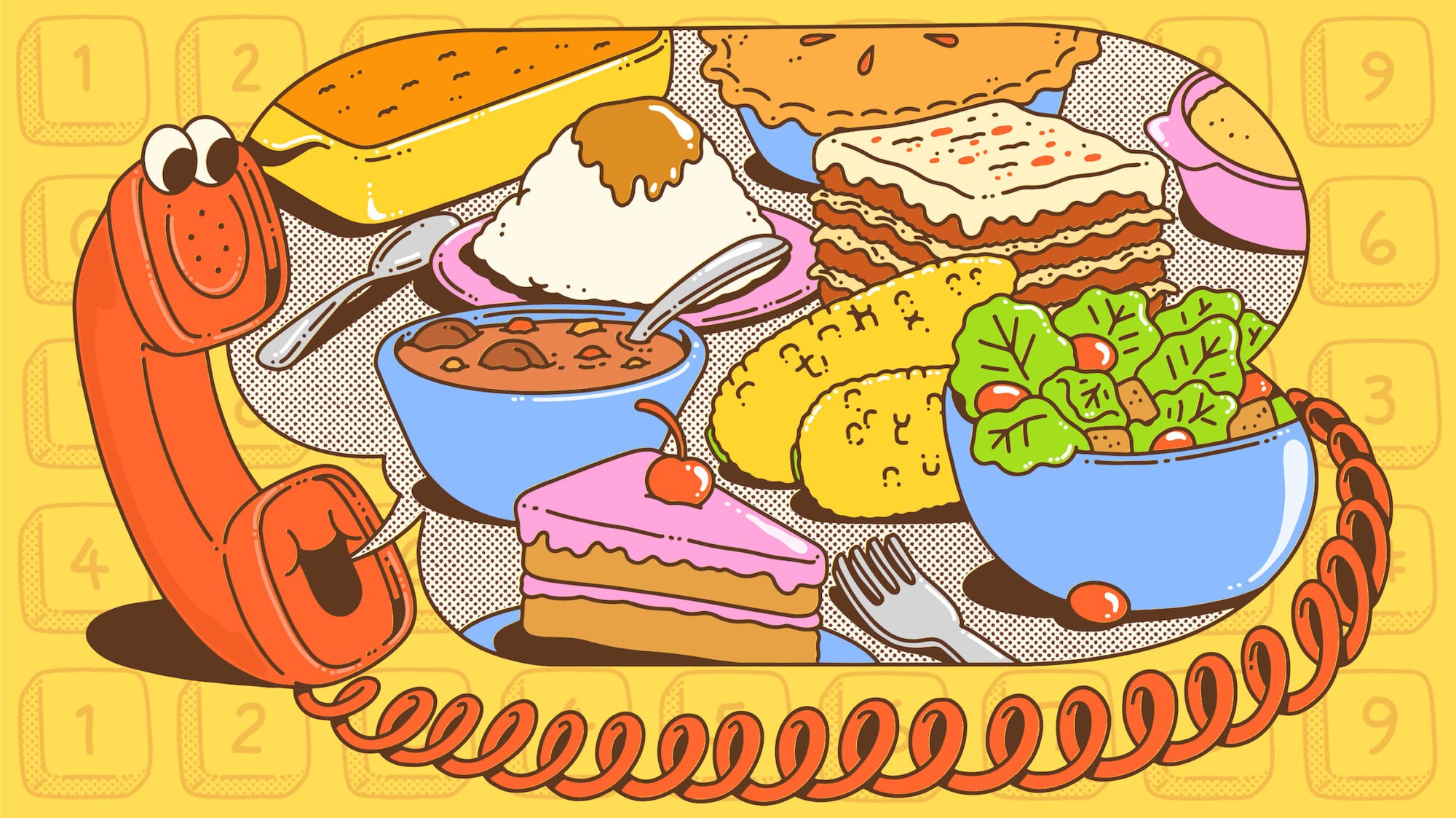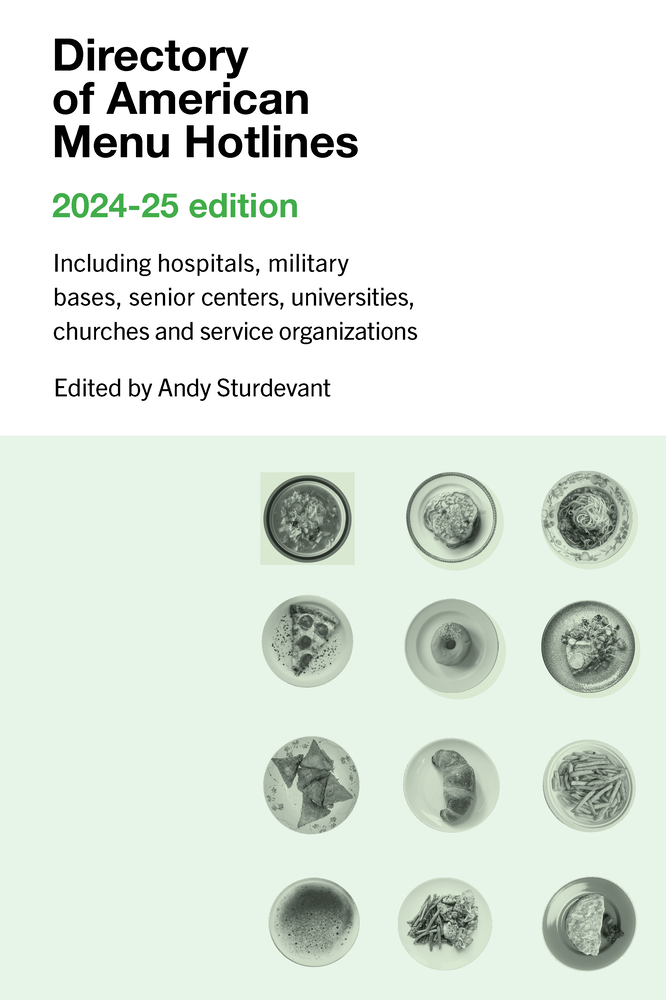
The menu telephone hotline is a relic, but it’s still active all around America today.
There is something inherently compelling about listing foods out loud. Think of Harlan Pepper naming those nuts in Best in Show, or Bubba’s ode to shrimp in Forrest Gump. We love to hear the names of different foods, organized into a list, and recited one after the other. While examples abound in TV and film, I’m happy to report that the most engaging paradigm exists in real life.
Consider the menu hotline. A quirky relic adrift in modern American food culture, an analog antidote to the Instagram drop, a curious window into the eating habits of folks across the country, menu hotlines provide an essential service to older, less web-literate demographics and an ephemeral snapshot of American foodways to curious callers. More evocative of landlines and phone books than websites and apps, these hotlines—and the deep food traditions they preserve—are still hanging on at a dwindling number of institutions and restaurants across the country. And they are all, by their very nature, just a phone call away.
Interested in hearing for yourself? Take a moment to call the Oyster’s Pearl Grill, the on-site dining facility at St. Charles Parish Hospital in Luling, Louisiana—at 985-785-4286. Each weekday morning, Sharon Brown, a veteran cafeteria worker with a mesmerizing, deliberate cadence, enthusiastically reads the day’s specials, like crawfish boil and sweet potato casserole, in a manner so unselfconscious and joyful that it makes me long to eat lunch there. And I’m not alone. “Quite a few people that are not even local call in and listen to it,” she tells me with pride.
One of those people is the Minneapolis-based artist and writer Andy Sturdevant, who compiled dozens of active hotline numbers into a zine called Directory of American Menu Hotlines, originally published in 2018 with a third update released this year. “Some people look at it and go, ‘Why does this exist?,’” he says, “And then there’s the small minority of people who find it really engaging.”
When Sturdevant’s directory came into my life—a pitch-perfect holiday gift from a dear friend—I wasn’t familiar with menu hotlines, but the project immediately spoke to me. As I called number after number (find a list of them at the bottom of this page), reaching prerecorded messages in Chambersburg, Pennsylvania; Albuquerque, New Mexico; and Dubuque, Iowa, a portrait of daily meals and dining habits in institutional settings like hospitals, senior centers, Air Force bases, and churches started to coalesce in my mind. Some dishes, like baked haddock at South Shore Hospital in Weymouth, Massachusetts, were familiar, while others, like “noodles Jefferson” at Creech Air Force Base in Indian Springs, Nevada, were not. (A quick search of the official US Army Quartermaster Corps website reveals a recipe that’s basically egg noodle mac and cheese.)
Consider the menu hotline. A quirky relic adrift in modern American food culture, an analog antidote to the Instagram drop, a curious window into the eating habits of folks across the country
What’s most striking is the way regional specialties (and even the more prosaic everyday foods) are brought to life through oral histories in miniature. “Even if you’re just doing your job,” Sturdevant says, “you’re still imbuing whatever dish is on the menu with some kind of lived experience in a way that’s really profound.”
While I could probably Google “speckled butter beans,” hearing about it from the hotline reader at the Original Harvey’s Family Restaurant in Taylors, South Carolina, frees it from the static confines of a Wikipedia page or an online recipe. The dish is presented by somebody who grew up eating it, contextually surrounded by other vernacular foods like calabash chicken, sliced ham with pineapple, and fried okra. “It’s rare in our times to find out about a dish for the first time from the place it’s actually from,” observes food writer Sara Bir, who wrote a foreword to the first edition of Sturdevant’s Directory. “Every meal, there’s a chance for a new discovery.”
Long enamored of her mother’s mid-century cookbooks, Bir finds resonance in what she calls “a little bit of that living anachronism of how we used to present food.” Because of the hotlines’ core audience, dishes that might strike younger folks as old-fashioned—like Salisbury steak or American chop suey—are “alive in these institutions,” Bir says.
Apart from the menu descriptions themselves, there is a wider cultural perspective to be gleaned from calling hotlines as a casual listener. I’m still in the multiple-hotlines-a-day part of my journey; Sturdevant and Bir warn me this pace can be tough to maintain long-term. Regardless of how frequently you call, you can learn that Friday is fried fish day in the South, that Wednesday night is community dinner night featuring “pizza hotdish” at the Lutheran church outside Minneapolis, and that entrées can cost less than $2 on Air Force bases. And, fine, there is the occasional curveball—like “fried sushi” at a hospital in Laurel, Mississippi.
It’s difficult to put a time stamp on the first menu hotline in the United States, and this topic didn’t turn up in the databases I scoured or ring any bells with the food historians I contacted. But University of New Hampshire media historian Josh Lauer told me that “the idea of providing public service information is something the telephone company was doing in the 1930s.”
The first example of this was a phone number people could call to hear the time and temperature. But because of concerns about privacy and wiretapping that date to Prohibition, the technology wasn’t made available to private consumers or businesses until 1968, and it didn’t become popular until the ’70s and ’80s. The most recognizable iteration, at least to older millennials and Gen Xers, may be the movie hotline Moviefone, founded in 1989. The earliest examples of menu hotlines I could find date to the mid-’90s.

Around 1996, there was a former used car salesman in metro Charlotte named David Price who became a local celebrity for his over-the-top recitations of school lunch menus, warbling side dishes like “fruit and a roll.” He received enough media coverage to “go viral” in a pre-smartphone sense, but he was clearly hamming it up for that purpose.
A more heartwarming example is the hotline reader Sharon Adl-Doost, who read menus for the US Geological Survey cafeteria in Reston, Virginia, around the same period. To cheer up callers, Adl-Doost would break into song at the end of each menu. Her story went viral, too, and Leslie Mello, then a designer at Vanity Fair and now a brand strategist in London, made a short documentary about her.
“What I found really interesting is that the menu line is different things for different people,” Mello tells me. “I think it’s really clear that we New York creatives kept calling it because it gave us something we didn’t have,” she remembers. “That good ol’ Southern hospitality is what we were really tapping into, and we liked to think we were above mashed potatoes and gravy or a hot dog bar, but we would have loved to eat every single thing,” she adds.
According to Mello, Adl-Doost’s viral moment slipped into territory that could be considered exploitative, with “superfans” emerging to try and manage a voiceover career. And while she eventually recorded some radio spots for McDonald’s, she was “never able to really make a living as voiceover talent,” Mello says.
The hotline readers of today—even the most gregarious among them—are just anonymously doing their jobs, without much fanfare (or many superfans). “It’s not performative,” says Bir. And if it feels that way, she adds, “it’s because it’s genuine.”
For those not in the local communities, treating these hotlines purely as entertainment would be missing the point; poking fun at regional accents or unfamiliar foods would be worse. These hotline readers and the institutions that employ them are stewards of a disappearing American art—they should be celebrated while they’re still around. As Bir put it, “It’s this little dose of purity, just by calling a number you’re lucky enough still exists. How cool is that?”
Select hotlines, in order of appearance. You can buy Directory of American Menu Hotlines for access to more hotlines.
St. Charles Parish Hospital (The Oyster’s Pearl Grill and Cafe), Luling, LA, 985-786-4286
Kirtland Air Force Base, Albuquerque, NM, 505-846-8050
South Shore Hospital, Weymouth, MA, 781-624-8434
Creech Air Force Base, Indian Springs, NV, 702-404-0844
The Original Harvey’s Family Restaurant, Taylors, SC, 864-631-2806
Westwood Lutheran Church, St. Louis Park, MN, 952-767-5579
South Central Regional Medical Center, Laurel, MS, 601-426-4975